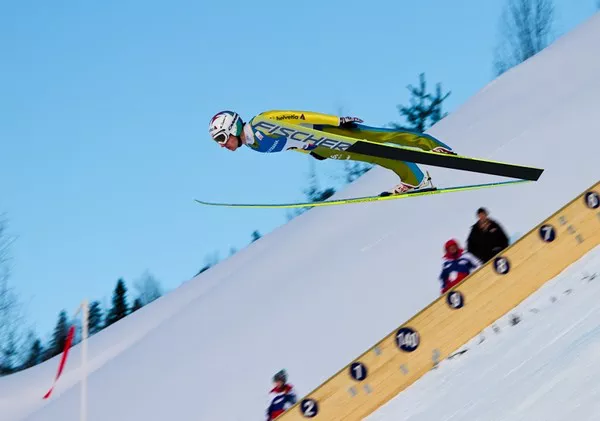The Winter Olympics, with its array of adrenaline-pumping sports, is a testament to human athleticism and the spirit of competition. Amidst the icy landscapes and snow-covered mountains, one sport stands out for its sheer spectacle and breathtaking display of skill: ski jumping. As athletes hurtle down towering ramps, defying gravity with each leap, ski jumping captivates audiences worldwide, embodying the essence of Olympic excellence.
A Sport Steeped in History
Ski jumping traces its origins back to the late 19th century in Norway, where it began as a mode of transportation before evolving into a competitive sport. Over time, it spread across Europe and eventually gained global recognition, becoming a staple of the Winter Olympics since the inaugural Games in Chamonix in 1924.
The Essence of Ski Jumping
At its core, ski jumping is a test of precision, technique, and courage. Athletes, known as jumpers, launch themselves off a specially designed ramp, known as the inrun, aiming to achieve maximum distance and style while maintaining stability in the air. The elegance of their flight, combined with the raw power of their descent, makes ski jumping a mesmerizing spectacle for both spectators and participants alike.
The Olympic Challenge
For ski jumpers, the Olympics represent the pinnacle of their sport, the ultimate stage where dreams are realized and legacies are forged. Competing on the Olympic stage requires not only exceptional physical prowess but also mental fortitude and unwavering focus. The pressure to perform under the gaze of millions is immense, yet it is this very pressure that often brings out the best in athletes, pushing them to surpass their limits and reach new heights of achievement.
Technical Mastery
Success in ski jumping hinges on mastering the technical aspects of the sport. Jumpers must possess impeccable form and timing to execute a flawless takeoff, allowing them to maximize their speed and trajectory off the ramp. Mid-flight, they must maintain a stable aerodynamic position, adjusting their body to counteract wind resistance and minor deviations in their trajectory. Finally, as they prepare for landing, they must anticipate the slope of the hill and adjust their posture accordingly to ensure a smooth and controlled descent.
The Physics of Flight
At its core, ski jumping is a battle against the forces of gravity and aerodynamics. As jumpers accelerate down the inrun, they convert their kinetic energy into potential energy, storing it for release upon takeoff. Once airborne, they must minimize air resistance by assuming a streamlined posture, reducing drag and allowing them to maintain their velocity through the air. Meanwhile, the slope of the landing hill serves to gradually decelerate the jumper, dissipating their energy safely as they come to a stop.
Equipment and Gear
Central to the sport of ski jumping is the equipment used by athletes. Modern ski jumpers rely on state-of-the-art gear designed to maximize performance and safety. This includes specialized skis, meticulously crafted to provide optimal lift and stability during flight, as well as aerodynamic suits that reduce drag and enhance the jumper’s speed. Additionally, helmets and protective padding are essential for safeguarding against injuries, ensuring that athletes can compete at the highest level with confidence and peace of mind.
Training and Preparation
Behind every successful ski jumper lies years of rigorous training and preparation. Athletes devote countless hours to honing their technique, building strength and endurance, and mastering the mental aspects of competition. Training regimens often include a mix of on-snow practice, strength and conditioning exercises, and mental visualization techniques aimed at cultivating the focus and resilience needed to excel on the Olympic stage.
The Thrill of Competition
For ski jumpers, the Olympic Games represent the culmination of years of dedication and sacrifice. Stepping onto the ramp amidst the roar of the crowd, they are driven by a singular goal: to soar further and higher than their rivals, to etch their names into the annals of Olympic history. With each jump, they push the boundaries of human potential, transcending the limits of what was once thought possible.
The Olympic Spirit
Beyond the quest for medals and glory, ski jumping embodies the spirit of the Olympic movement itself – a celebration of unity, friendship, and fair play. In a world divided by borders and politics, the Olympics serve as a reminder of our shared humanity, bringing together athletes from every corner of the globe to compete not as adversaries, but as equals. In this spirit of camaraderie, ski jumpers forge bonds that transcend nationality and culture, united by their love of sport and their commitment to excellence.
Conclusion
As the Winter Olympics continue to captivate audiences around the world, ski jumping remains a shining beacon of athletic excellence and human achievement. From its humble beginnings in the mountains of Norway to its place on the grand stage of the Olympic Games, ski jumping has captured the imagination of millions, inspiring awe and admiration with each gravity-defying leap. As we marvel at the feats of these remarkable athletes, let us not only celebrate their triumphs but also honor the values of sportsmanship, perseverance, and unity that lie at the heart of the Olympic ideal.

